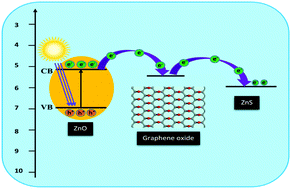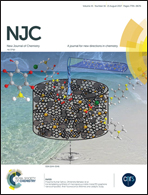Understanding the mechanism of enhanced charge separation and visible light photocatalytic activity of modified wurtzite ZnO with nanoclusters of ZnS and graphene oxide: from a hybrid density functional study†
Abstract
Recently, semiconductor photocatalysts have received significant interest in addressing the global energy and environmental crisis. Despite the great potential application of zinc oxide (ZnO), the utilisation efficiency of solar energy is limited only to the ultraviolet (UV) region. Therefore, our research interest is centred on the development of a model hybrid ZnO-based photocatalyst material with efficient photocatalytic performance and stability. A hybrid ternary ZnS/graphene oxide (GO)/ZnO system, where the band edges of the individual components in the heterostructure will have a step-wise structure for harvesting a broader portion of the solar spectrum, is an excellent solution. Herein, we explore the charge transfer, the improved photocatalytic mechanism, and the electronic and interfacial properties of the hybrid van der Waals (vdWs) ZnS/GO/ZnO heterostructure for the first time by carrying out comprehensive hybrid density functional theory calculations. Our results reveal the existence of vdWs interaction, enhance charge transfer, narrow the band gap and show remarkable improvement in the visible light photocatalytic activity of the heterostructures compared to pure ZnO. This enhancement is ascribed to the electron acceptor–transporter role played by the GO sheet in the interfacial layer of ZnS and ZnO. According to adhesion energy results, the monolayers are in contact and form stable heterostructures. The calculated charge density difference shows interlayer charge transfer from the ZnO(001) surface to the ZnS(110) surface through the GO sheet. Most significantly, the ZnS/GO/ZnO heterostructures exhibit a type-II band alignment, which significantly restrains the recombination of charge carriers. The band edge positions of ZnS/GO/ZnO with enough driving force for electron and hole transfer are well aligned for the feasibility of splitting water into H2 and O2, as well as for photodegrading pollutants in the water system. Therefore, the vdWs ZnS/GO/ZnO heterostructures appear as a new type of photocatalyst material for solar energy application. This study illustrates the usefulness of using low cost GO as an interfacial electron acceptor–donor to boost the photocatalytic performance of ZnO-based photocatalysts. The findings in this study provide a theoretical basis for developing highly efficient ZnO-based photocatalysts, as well as attract broad interest in VdWs heterostructure research in photocatalysis.



 Please wait while we load your content...
Please wait while we load your content...